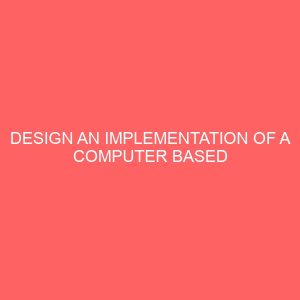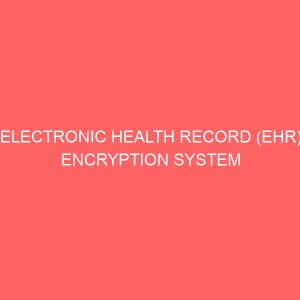Description
ABSTRACT
Handling of cargo has been a circular task all these while in our various ports. And Nigerian Ports Authority N.P.A being an organization responsible for seeing to the affairs of our various sea ports in Nigeria, have worked endlessly to make sure cargoes are properly handled without much complain of damage or misplacement. To ease the operation of cargo handling in our sea ports, researcher took up this study by critically understanding the work, procedure involved, analysis of the various steps and at the same time detecting problem in the present system and designing a new system that has solution to the problem of the existing system. Therefore, the researcher seek to design a system that will be able to handle the cargoes billing system, and process each cleared container, the system will also make a proper registration of importers cargoes or container with its container ID or track ID and contents, which will enable each container placement accurate. To archive this system the user will develop the system as a web base application which will allow importers and exporter to make there bill payment and get there containers cleared, even at a distance, therefore, this system will be deployed using PHP, Javascript, Native Java, Jquery, Ajax and mySQL for its development.
CHAPTER ONE
INTRODUCTION
Nigeria Ports Authority is a government owned organization under the supervision of the federal Ministry of transport with responsibility of providing specific ports and labor services for the countrys meantime industry.
One of their numerous duties and major functions is the provision of Cargo Handling Quays facilities. Right from the inception of this company, the billing system has been manually processed. The port complex is in the early stage of computerization and the manual method of preparing customers bills are delayed.
A computer-based billing system is necessary for handling and preparing of accurate bills for customers. The new system will facilitate the prompt preparation of bills, easy retrieval of information, security to vital information and resource sharing among the billing department.
1.1BACKGROUND OF STUDY:
Once Port complex is located near Port Harcourt, Rivers State of Nigeria, the port is a natural port and was established about twenty years ago, firstly with the construction and commissioning of the Federal Lighter Terminal FLT in 1982 and later the Federal Ocean Terminal FOT in 1996.
These two terminals handle lighter smaller vessels and oceangoing vessels respectively. The average draught of FLT is about 5.7m while that of FOT is about 13.0m being the cheapest in the West and Central African subregion. In this regard, the FOT is envisaged to be attracting more cargo ship and traffic not only as a transit but also as a transshipment center in the sub region. It however did not have any mechanical handling equipment for billing.
The billing system is presently handling manually by the marketing department of this port. The marketing department of the port took over the function of revenue billing from the traffic department in the 80s. Their main function is to raise customers bills of all statutory charges against port users for the services rendered to them. These services includes Rental period at the number of days the consignment in within the port vicinity, NPA shore handling, transfer service, documentation, terminal delivery value added tax VAT and miscellaneous.
The role at which the bills are prepared with the increasing number of customer is insignificant. There are procedural ways in which these bills are being prepared. They are the provisional bills of vessels, the final bills of vessels and the miscellaneous bills. A staff has to raise as many bills as the number of the customer increases: more importantly, delays bring extra cost on the importer, and this makes the importer feel disappointed when they come to collect their raised bills.
Hence, a thorough investigation and analysis of the manual billing method enables me to gain understanding on the true nature of their problems and design a computerized seaport billing system that would bring solutions to the problem inherent.
1.2STATEMENT OF PROBLEM
History has it that the billing system in Nigeria Port Authority, one port has been plagues by several factors based on the current manual process by the use of the Draft import Debit and import Debit Note, these factors includes:
Fills and records are not properly kept
Errors are easily made and hardly detected
A lot of time is wasted to prepare bills
Information is not well documented
Security of files or document is not granted.
1.3PURPOSE OF STUDY
The main aim of this study is to computerize Nigeria Ports Authority, Onne Port billing system in order to improve their transaction rate of services to their various customers.
1.4OBJECTIVE OF THE STUDY
The primary aim of this project research is to develop a computerbased seaport billing system that will handle the bills raised for various customers specifically in NPA, Onne Port. A computer based system can be batched or interactive. A batch processing system is one where transactions are accumulated into batches of suitable sizes, then each batch is sorted and processed as a simple unit. Batch processing has a degree of delay. Interactive systems are those which allow the user to input data in response to the information displayed on the screen.
This project is concerned with only ever, the researcher touched all parts of system design that will enhance a computer based billing system in NPA.
TABLE OF CONTENT
Title page
Certification
Dedication
Acknowledgment
Abstract
Table of contents
CHAPTER ONE
Introduction
1.1Statement of problem
1.2Aims and objective
1.3Purpose of study
1.4Importance of study
1.5Scope of the study
1.6Limitation of the study
1.7Definition of terms
CHAPTER TWO
Literature Review
CHAPTER THREE
DESCRIPTION AND ANALYSIS OF THE EXISTING SYSTEM
3.1Method of Data collection
3.2Organization structure
3.3Objective of the existing system
3.4Input process, output analysis
3.5Input specification and design
3.6File design
3.7Information flow diagram
3.8System flow chart
3.9Problem of existing system
3.10Justification of the new system
CHAPTER FOUR: SYSTEM IMPLEMENTATION
4.0The new system design
4.1Output specification and design
4.2Procedure chart
4.3System requirement
4.4Program design
4.5Program flow chart
4.6Pseudo code
4.7Test run
4.8System documentation
CHAPTER FIVE
CONCLUSION AND RECOMMENDATION
5.1Conclusion
5.2Recommendation
REFERENCE








Reviews
There are no reviews yet.